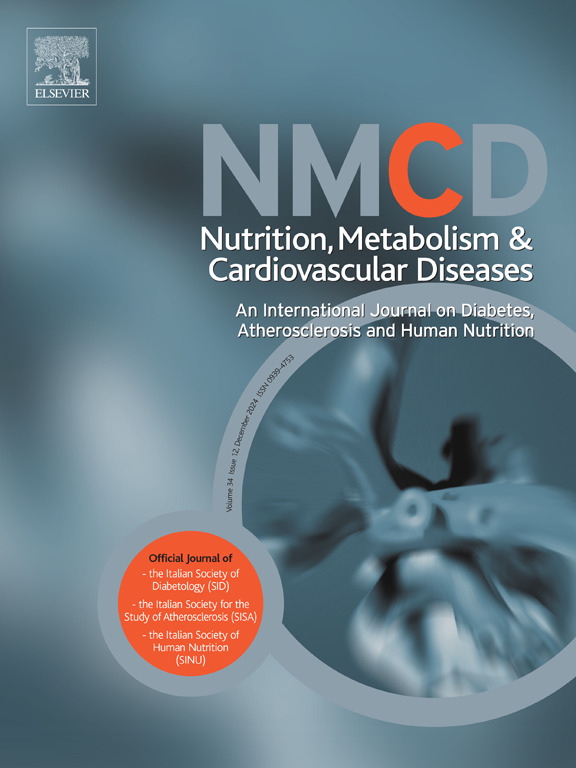The impact of semaglutide on liver fat assessed by serial cardiac CT scans in patients with type 2 diabetes: Results from STOP trial
IF 3.7
3区 医学
Q2 CARDIAC & CARDIOVASCULAR SYSTEMS
Nutrition Metabolism and Cardiovascular Diseases
Pub Date : 2025-04-05
DOI:10.1016/j.numecd.2025.104036
引用次数: 0
Abstract
Background and aim
The prevalence of hepatic steatosis continues to increase worldwide. Hepatic steatosis is increasingly recognized as an independent risk factor for cardiovascular mortality. However, there are limited options for the treatment of fatty liver. In this study, we evaluated the effect of semaglutide on liver fat as measured by non-contrast cardiac CT scans.
Methods and results
STOP is a randomized controlled trial that evaluated the semaglutide treatment effect on coronary atherosclerosis progression (STOP) in type 2 diabetes. We utilized unenhanced cardiac CT scans to quantify liver fat based on the CT Hounsfield attenuation method. Of the 140 subjects who were originally randomized, a total of 114 individuals qualified for this study. 59 participants were in the semaglutide group and 55 were in the placebo group, and these subjects were followed for 12 months. The secondary outcome (liver fat attenuation) was quantified using non-contrast cardiac computed tomography (CT) images at both the baseline and 12-month follow-up time points. Multivariate regression models were then used to evaluate the change in liver fat content overtime.
One hundred and fourteen subjects were included in the study: 61 % male, mean age of 57.8 ± 8.1 years, and mean BMI of 32.0 ± 6.7. The average of three liver measures over 12 months showed an improvement in the semaglutide group of 1.4 ± 9.0 mean HU, versus a worsening in the placebo group of 1.9 ± 9.5 mean HU. The multivariable linear regression models (after adjusting for age, gender, BMI, hypertension, hyperlipidemia, past smoking and baseline liver attenuation) showed that average liver attenuation measures improved by 4.4 HU in the semaglutide group when compared to the placebo group (p = 0.002). This result demonstrated improvement in the liver fat content within the treatment group.
Conclusion
In type 2 diabetes patients with hepatic steatosis, treatment with semaglutide resulted in a significant improvement in fatty liver reduction when compared to placebo.
通过2型糖尿病患者心脏连续CT扫描评估西马鲁肽对肝脏脂肪的影响:来自STOP试验的结果
背景与目的:肝脂肪变性的患病率在世界范围内持续上升。肝脂肪变性越来越被认为是心血管疾病死亡的独立危险因素。然而,治疗脂肪肝的选择有限。在这项研究中,我们通过非对比心脏CT扫描评估了西马鲁肽对肝脏脂肪的影响。方法和结果:STOP是一项随机对照试验,评估西马鲁肽治疗2型糖尿病冠状动脉粥样硬化进展(STOP)的效果。我们利用未增强的心脏CT扫描,基于CT Hounsfield衰减法来量化肝脏脂肪。在最初被随机分配的140名受试者中,共有114人符合这项研究的条件。59名参与者在西马鲁肽组,55名参与者在安慰剂组,这些受试者被跟踪了12个月。在基线和12个月随访时间点,使用非对比心脏计算机断层扫描(CT)图像对次要结局(肝脏脂肪衰减)进行量化。然后使用多变量回归模型来评估肝脏脂肪含量随时间的变化。纳入研究的114名受试者中,男性占61%,平均年龄57.8±8.1岁,平均BMI为32.0±6.7。12个月内三次肝脏测量的平均值显示,西马鲁肽组的平均HU改善为1.4±9.0,而安慰剂组的平均HU恶化为1.9±9.5。多变量线性回归模型(在调整了年龄、性别、BMI、高血压、高脂血症、既往吸烟和基线肝衰减后)显示,与安慰剂组相比,西马鲁肽组的平均肝衰减测量值提高了4.4 HU (p = 0.002)。该结果表明,治疗组肝脏脂肪含量有所改善。结论:在伴有肝脂肪变性的2型糖尿病患者中,与安慰剂相比,西马鲁肽治疗可显著改善脂肪肝的减少。
本文章由计算机程序翻译,如有差异,请以英文原文为准。
求助全文
约1分钟内获得全文
求助全文
来源期刊
CiteScore
6.80
自引率
2.60%
发文量
332
审稿时长
57 days
期刊介绍:
Nutrition, Metabolism & Cardiovascular Diseases is a forum designed to focus on the powerful interplay between nutritional and metabolic alterations, and cardiovascular disorders. It aims to be a highly qualified tool to help refine strategies against the nutrition-related epidemics of metabolic and cardiovascular diseases. By presenting original clinical and experimental findings, it introduces readers and authors into a rapidly developing area of clinical and preventive medicine, including also vascular biology. Of particular concern are the origins, the mechanisms and the means to prevent and control diabetes, atherosclerosis, hypertension, and other nutrition-related diseases.

 求助内容:
求助内容: 应助结果提醒方式:
应助结果提醒方式:


